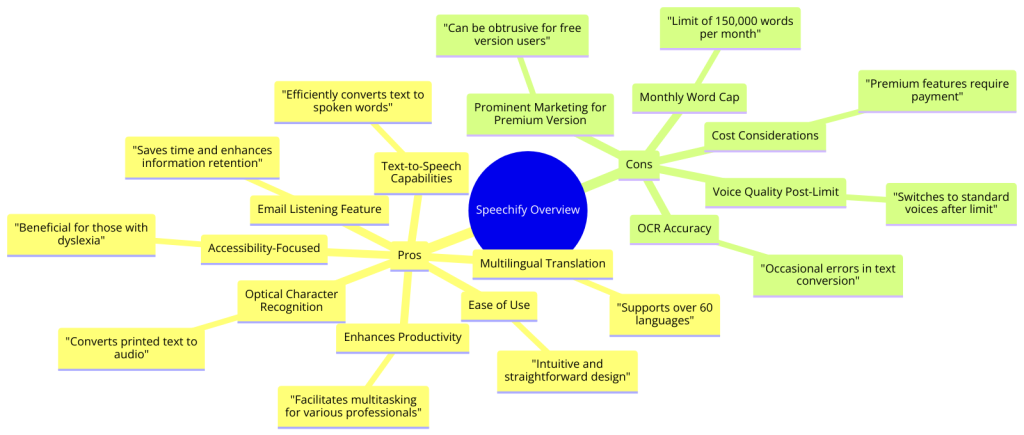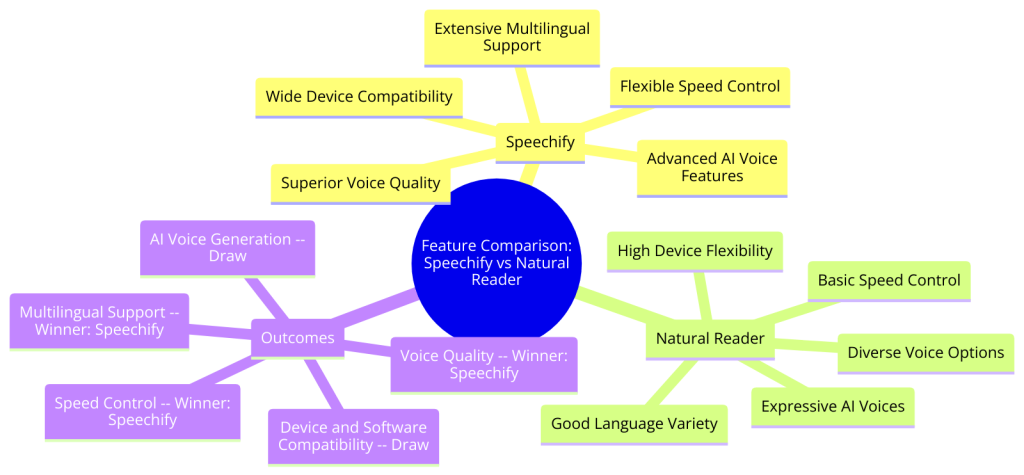In our previous reviews, we analyzed Speechify and Speechify alternatives. In the current article we are going to delve into Speechify vs Natural Reader: which text-to-speech software will transform your reading experience? As we navigate through the vast landscape of digital tools, the ability to convert text into spoken words is not merely a convenienc – it is a transformative asset for students, professionals, and casual readers alike. In this detailed comparison, we’ll explore each platform’s unique features, user-friendliness, and overall performance. Discover the benefits and limitations of Speechify and Natural Reader, and determine which tool is the optimal choice for enhancing your daily reading routine. Continue reading as we dive deep into the world of text-to-speech technology, and find out which software comes out on top in making information more accessible and engaging than ever before!
Possible application of text to speech tools could be generating Cartoon Character Voices (see the Best AI voice generator text to speech characters tools) and AI voice generator for characters (see the Cartoon Character Voices best tools).

If you’re wondering why you should trust this blog over all the others on the subject, read my biography.
AFFILIATE DISCLOSURE: This website uses affiliate links which may earn a commission at no additional cost to you.
Speechify vs Natural Reader: a quick verdict of Speechify
Speechify is a leading text-to-speech application known for its exceptional ability to convert text into clear, lifelike spoken words. This tool is immensely beneficial for a diverse group of users, including students, professionals, and individuals with reading difficulties, as it improves access and facilitates learning via its audio features. Speechify leverages cutting-edge technology to produce speech that closely resembles human voices, making extensive reading material more manageable and engaging. Its broad utility spans from enabling people to enjoy books audibly to helping professionals efficiently review long documents. With an intuitive interface and easy-to-use functionalities, Speechify is an outstanding resource for anyone looking to effortlessly convert written content into speech.

Pros:
- Ease of Use: Speechify’s design is intuitive and straightforward, making it accessible for individuals regardless of their tech skills.
- Text-to-Speech Capabilities: The software efficiently converts written text into spoken words, aiding in identifying errors and refining written work.
- Optical Character Recognition: This feature enables the transformation of printed text into audio format, essentially converting physical books to audiobooks.
- Accessibility-Focused: The software is particularly beneficial for those with dyslexia, enhancing their reading experience.
- Enhances Productivity: For professionals like editors, students, and content creators, Speechify facilitates multitasking by allowing users to listen to text content.
- Multilingual Translation: With support for over 60 languages, it serves as a useful tool for those learning new languages or for multilingual users.
- Email Listening Feature: Users can listen to their emails through the software, saving time and ensuring no critical information is overlooked.
Cons:
- Monthly Word Cap: The premium version imposes a limit of 150,000 words per month, which might be restrictive for heavy users.
- Prominent Marketing for Premium Version: The push for the premium version can be obtrusive and impact the user experience for those using the free version.
- OCR Accuracy: Although effective, the optical character recognition isn’t always flawless, with occasional errors in converting printed text to audio.
- Voice Quality Post-Limit: Once the limit for premium voices is reached, the software switches to standard voices, which may sound less natural.
- Cost Considerations: While a free version is available, its features are limited, and the cost of the premium version may not fit into everyone’s budget.
Speechify vs Natural Reader: a quick verdict of Natural Reader
Natural Reader is an innovative text-to-speech software designed to make written content accessible to a wider audience, including those with visual impairments or reading difficulties. It stands out for its simplicity and effectiveness, enabling users to convert any written text, from documents to web pages, into spoken words with ease. This versatility makes Natural Reader an invaluable tool for everyday life, enhancing the user’s ability to multitask and access information in alternative formats.

Pros of Natural Reader:
- User-Friendly Interface: The software offers an intuitive and straightforward layout, making it easy for users of all tech levels to navigate.
- Wide Range of Voices: Users can choose from a variety of voices in different accents and languages, allowing for a personalized audio experience.
- Support for Multiple Formats: Natural Reader can handle various file types including PDFs, Word documents, and eBooks, which is particularly useful for professional and educational environments.
- Integration Capabilities: It integrates smoothly with browsers and other software, enhancing its utility by allowing direct text-to-speech conversion from the web.
- Free Version Available: There is a free version of the app, which is excellent for users wanting to test its features before committing to a purchase.
Cons of Natural Reader:
- Limited Features in Free Version: While the free version is useful, it is considerably limited in functionality compared to the paid versions.
- Occasional Voice Quality Issues: Some users have reported that the synthesized voice can sometimes sound unnatural or robotic, particularly with complex text.
- High Cost of Premium Features: The more advanced features, including many voices and integration options, are locked behind a paywall, which might deter some users.
- Performance Issues on Mobile: Some users have noted that the mobile version of the app does not perform as seamlessly as the desktop version, particularly when handling large files.
Speechify vs Natural Reader: quick comprison insights
Overall Winner: Speechify emerges as the overall winner in this comparison.
Key Winning Features for Speechify:
- Voice Quality: Speechify takes the lead with higher quality voices, providing a more natural listening experience.
- Translation Features: Speechify offers superior translation capabilities, allowing for broader language accessibility.
- Speed Control: Speechify provides better speed control options, giving users the flexibility to adjust the speech tempo according to their preferences.
Free Plan: Natural Reader stands out by offering a more advantageous free plan, appealing to users who are looking for basic text-to-speech services without upfront costs.
Tied Categories:
- Pricing: Both Speechify and Natural Reader are evenly matched in terms of their pricing structures.
- Design & Functionality: Both applications offer a comparable level of design quality and functional ease of use.
- Device and Software Compatibility: Both are compatible across a range of devices and software, ensuring broad usability.
- AI Voice Generation: Both Speechify and Natural Reader are on par in their use of AI for voice generation.
In summary, while Speechify has more specialized features leading to its win in several categories, Natural Reader offers a strong free plan and matches Speechify in several foundational aspects such as pricing and device compatibility.
Pricing comparison
Speechify pricing
Free
Simple way to get started
- AI Voice Over
- Video, Slide, and Image support
- Try all 200+ voices
- All 20+ languages & accents
- Support adding pauses
- 10 minutes of voice generation
- Support adjusting pronunciation
- Support uploading of .txt, .docx, .srt scripts, as well as Youtube URLs
Basic
The basics for individuals
Everything in Free
- Download as video, audio, or text
- Video and audio Dubbing
- Video and audio Transcription
- 50 hours of voice generation per user/year
- 12 hours of Dubbing per user/year
- 50 hours of Transcription per user/year
- Commercial usage rights
- 8000+ licensed soundtracks
- Thousands of Stock Images & Videos
Professional
For professionals and teams
Everything in Basic
- AI Avatars
- Voice Cloning
- 100 hours of voice generation per user/year
- 36 hours of Dubbing per user/year
- 100 hours Video and Audio Transcription
- 1 hour of AI Avatar Video/year
Natural Reader pricing
Free
For individuals to start
- Unlimited use with Free voices
- Miniboard to read tet in other applications
- Pronunciattion editor
- Works with PDF, DOC TXT, EPUB
Premium
Monthly – $9.99/ month
Yearly – $59.88/ year
- Includes personal web app, mobile app, and Chrome extension
- Supports pdf, epub, doc(x), ppt(x), numbers, pages and more
- Unlimited listening with non-AI Premium Voices
- Convert to mp3 (for personal use only) – 1 million characters per month
- OCR (read from images and scanned documents)
- Pronunciation Editor
- AI Smart Filter (skip page numbers, charts, tables, etc)
Plus
Monthly – $19/ month
Yearly – $110/ year
Everything in Free
- Includes personal web app, mobile app, and Chrome extension
- Supports pdf, epub, doc(x), ppt(x), numbers, pages and more
- Unlimited listening with non-AI Premium Voices
- 500,000 characters/day listening with Plus Voices*
- Convert to mp3 (for personal use only) – 1 million characters per month
- OCR (read from images and scanned documents)
- Pronunciation Editor
- AI Smart Filter (skip page numbers, charts, tables, etc)
Features comparison

Voice Quality
Speechify excels with its exceptionally realistic and pristine voices, offering a variety that closely mimics human speech. It allows users to adjust the speed and pitch, tailoring the auditory experience to their personal liking. Speechify also provides a range of voices across many commonly spoken languages, catering well to users needing multilingual support.
Conversely, Natural Reader presents a robust selection of both synthetic and natural voices. This diversity enables users to select from different genders and accents, from American to British English, enhancing the personalization of the listening experience. It also features a pronunciation editor, allowing further customization by adjusting the pronunciation of specific words.
Voice Quality Winner: Speechify, with its superior voice quality and extensive customization options, is ideal for those seeking the most natural-sounding text-to-speech service. However, Natural Reader’s diverse voice options provide a solid choice for users with less emphasis on voice realism.
Multilingual Support & Translation Features
Speechify shines in multilingual support, offering an extensive selection of languages and accents. This makes it an excellent option for those who need to listen to content in various languages for work, study, or enjoyment.
Natural Reader also offers a respectable variety of languages, though not as extensive as Speechify’s. It covers many common languages and suits those with needs for specific languages well.
Multilingual Support Winner: Speechify is the top choice for its wide range of languages and accents, ideal for frequent multilingual interactions. Natural Reader remains a competent option for users with less diverse language needs.
Speed Control
Speechify allows users to customize their listening experience extensively, offering a wide array of reading speeds to match any preferred pace, from slow and methodical to quick and succinct.
Natural Reader provides speed control options as well, though its range is not as broad as Speechify’s. Users needing faster reading speeds might find Natural Reader’s maximum speed somewhat limiting.
Speed Control Winner: Speechify offers greater flexibility in speed adjustments, catering to a wider variety of listening preferences and needs.
Device and Software Compatibility
Speechify is highly compatible across multiple devices, including iOS, Android, Mac, and Chrome, and integrates seamlessly with platforms like Google Drive.
Natural Reader also boasts significant compatibility, available on Windows, Mac, iOS, Android, and via a web-based application, making it accessible from any internet-connected device.
Compatibility Verdict: It’s a draw. While Speechify integrates well with common platforms, Natural Reader’s web-based application provides unmatched convenience for those preferring browser access.
AI Voice Generation
Speechify leverages advanced AI technology to create lifelike voices and offers features like AI Voice Studio and AI Voice Actors, making it versatile for various content creation needs.
Natural Reader focuses on producing high-quality AI-generated voices suitable for commercial use, capable of expressing various emotions to enhance the listening experience.
AI Voice Generation Verdict: Tie. Speechify is suited for creating a range of content, while Natural Reader excels in generating emotive and engaging voices for commercial applications.
Other Text-to-speech tools
- Speechelo: this speech synthesis program is notable for its realistic voice renderings. Leveraging AI technology, it produces voices that sound authentic in a variety of languages. Speechelo is particularly suited for developing instructional videos, podcast content, and conversational bot communications. Additionally, it offers extensive personalization options, including both male and female voices with a range of tonal variations. Read more in our Speechelo review.
- Murf AI is a versatile AI-powered voice generator that enables the creation of studio-quality voiceovers in minutes. It offers lifelike AI voices for various applications such as podcasts, videos, and professional presentations. With Murf, users can choose from over 120 voices in 20+ languages, and it includes features like pitch control, emphasis adjustment, and syncing with video, music, or images. It’s designed for a range of users, including product developers, educators, marketers, authors, corporate coaches, and podcasters, among others. Murf AI emphasizes ease of use, security, and the ability to produce high-quality, natural-sounding voiceovers rapidly. Read more in our Murf AI review.

- Lovo: Renowned for its artificial intelligence-based voiceover capabilities, Lovo offers more than 50 realistic-sounding voices in various languages. Its intuitive interface makes it an attractive choice for content creators seeking a reliable AI voice generation tool.
- Play.ht is an AI Voice Generator platform offering realistic text-to-speech and AI voiceover services. It uses advanced AI to convert text into natural-sounding human-like voices across various languages and accents. Their products include AI Text to Speech, AI Voice Cloning, and Voice Generation API. Play.ht is used for a wide range of applications such as voiceovers for videos, audio publishing, e-learning, podcasts, gaming, and more. They boast a large library of over 900 AI voices in 142 languages and accents, and their technology supports various speech styles, emotions, character voices, and custom pronunciations. Read more in our Play HT review.
- Revoicer is an AI-powered text-to-speech (TTS) software that offers high-quality, natural-sounding voiceovers. It is designed to provide a more human-like voice than many other TTS online solutions, and it supports a wide range of languages. This makes Revoicer a versatile tool for various applications including creating voiceovers for podcasts, audiobooks, sales videos, social media content, and more. Read more in our Revoicer review.
Speechify vs Natural reader: conclusion
In conclusion, the comparative analysis between Speechify and Natural Reader highlights several key strengths and weaknesses of each platform. Speechify stands out with superior voice quality, extensive multilingual support, and flexible speed control, making it an excellent choice for users seeking a natural and customizable listening experience. Natural Reader, while offering a wide variety of voices and good device flexibility, does not quite match the versatility of Speechify but remains a solid option for those with specific, less demanding needs. Both platforms perform equally well in AI voice generation and device compatibility, ensuring they are accessible on a broad range of devices. Ultimately, Speechify appears to be the more robust tool overall, especially for users who require a rich feature set and high-quality audio output.
Speechify vs Natural reader: FAQ
Is Speechify Better Than NaturalReader?
When comparing Speechify with NaturalReader, Speechify generally offers more advanced features like superior voice quality and extensive multilingual support, making it a more robust choice for users seeking a high-quality listening experience.
Is NaturalReader Worth It?
NaturalReader is definitely worth considering, especially for those who need a reliable text-to-speech tool with a variety of voices and the flexibility of a web-based application. Its pronunciation editor and voice options provide significant value for casual and professional users alike.
Is NaturalReader Completely Free?
NaturalReader offers a free version, which includes basic text-to-speech features that are useful for everyday tasks. However, more advanced features and a wider selection of voices are available in the paid versions, catering to users with specific needs or professional requirements.
What is the Difference Between Speechify and Speech Central?
The main difference between Speechify and Speech Central lies in their core functionalities and user interfaces. Speechify excels in producing high-quality, natural-sounding voices and offers robust translation features, whereas Speech Central is more focused on providing a straightforward text-to-speech service with standard features for reading texts.






